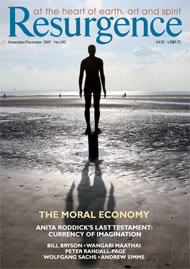IN THE RECENT history of anthropogenic climate change, there has thus far been a largely inverse relationship between political power and action taken. Faced with unthinkable calamity for all life, the international response has been an unending string of ineffective conferences, a panoply of meek targets with weak enforcement, a raft of business- and industry-friendly market mechanisms, and a seemingly eternal wait for binding international agreements.
Political power is generally more restricted the higher one goes, so local initiatives commonly prevail where there is good organisation; the Transition Towns initiative shows great promise, for example. Most citizens want exciting, innovative responses at the local level. However, there are some governments that buck the trend. Although in the UK this may be somewhat hard to grasp, other countries are not only good at spotting problems and finding bold, win-win-win solutions – they also have the will to manoeuvre them through parliament and into law.
Germany in particular has demonstrated such initiative in many areas, including the most crucial: energy. It has consistently supported renewable energy and has made excellent gains in increasing the share of it in the national energy mix, thereby reducing inputs of fossil fuels and nuclear. It is in fact committed to phasing out nuclear energy, although this is being hotly debated once more by those with vested interests. Because Germany’s energy demand has remained fairly flat, the use of renewables has achieved a net reduction in national CO2 emissions. It has to be acknowledged that much of the success in achieving these goals is because of government power-sharing with the Green Party.
Since 1990, German governments have been developing and fine-tuning legislation to facilitate the transition. Their Renewable Energy Law of 2000 is probably the most effective and cost-effective law yet devised to support the deployment of renewable energy. It is a feed-in tariff (FIT), which obliges utilities to purchase electricity from renewable energy producers. It costs more to generate electricity from some sources, so FITs scientifically calculate a tariff for each, thus ensuring profitability. Finally, the duration is set, usually for 20 years. Thus, between all of these guarantees, investors know exactly what their return will be, and for how long. This lowers investment risk, and hence cost.
Germany has set no limit to the amount of renewable energy that can be fed into the grid, and indeed people say that it is almost a national sport to see how little energy citizens can take from the utilities. Needless to say, this has not gone unnoticed by the conventional energy industry, which has relentlessly attacked the law since first realising that it could have a significant effect on its market share. The conventional industry advocates a system similar to the UK’s Renewables Obligation. This uses a market-based model called a ‘quota’ system, which sets an amount of generation to be achieved, and producers receive ‘green certificates’ for their energy, which can be sold for extra income. Because the future value of the certificates is unknown, as it is linked to the future market price, the uncertainty created attracts extra risk pricing in the financing of renewable energy projects. This extra cost makes it a more expensive, complex system, which excludes all but the most determined and credit-worthy investors.
The effect is to produce a market dominated by large energy companies, which excludes independent power producers. Therefore, the democratisation and true decentralisation of energy is thwarted, an effect which has still to be grasped by the public.
FITs do more than any other policy to promote cheap building-integrated renewables, and avoid costly third-party financing arrangements. Buildings can and should become net energy producers, especially if designed or retrofitted with energy efficiency in mind. We will soon have widespread ‘breeder plants’, where renewable-energy-powered factories produce renewable-energy products. Although this is an inevitable step, it is exciting to know that people are moving towards it already.
Today, around forty-five countries, states and provinces are using FITs to help establish or develop their domestic renewables market, and no wonder, when the statistics from Germany are so impressive. Despite various periods of slow economic growth and recession since the introduction of the first feed-in law at the dawn of the 1990s, Germany has enjoyed strong, sustained growth in the sector. It now employs towards a quarter of a million people, compared to a few thousand in the UK. Its annual turnover is around £14.5 billion, while the UK’s is around £280 million. Renewable energy in Germany saved 83 million tonnes of CO2 from being emitted in 2005, and in 2007 around 12.5% of electricity consumption comes from renewables.
Germany is now world leader for installed capacity of solar photovoltaics, and is leading the way in other solar technologies. Japan, Spain, the USA and now China are also top manufacturers in this field.
Spain has a very good FIT system also, and is creating a massive industry of its own. It joined with Germany to create the international Feed-in Cooperation, which hosts biannual workshops to exchange information and experience on FITs, including technical, legislative, administrative, political and other matters. They have now been joined by Slovenia. In the continued absence of an international renewable energy agency, such partnerships are a necessity.
With so many good FIT systems emerging, the industry is finally getting the good run that its benefits warrant, which include environmental protection, energy security and job creation.
IN ADDITION, OTHER policies and practices are promoting more sustainable industrial practices, such as ‘industrial symbiosis’ approaches, where the waste materials from one industry become feedstocks for another. Whole ‘eco-industrial parks’ have been set up on this basis. This ‘biomimicry’ approach, or copying from Nature’s behaviour and systems, is one of the most important for us to perfect. Nature tends to avoid waste, conserve energy and live within its means.
German waste management legislation is also excellent. Before Germany took serious steps in this field, each urban area had its own landfill site – totalling around 50,000 across the country. This was cut to below 2,000 by the millennium, and strict operational regulations were introduced. The waste hierarchy approach of ‘Reduce, Reuse, Recover’ successfully became the operating concept in this area.
The waste management sector in Germany now employs more than 250,000 people, including engineers, refuse workers and civil servants. Colleges run waste management courses and there is even special training for professions in the waste disposal sector. Annual turnover in the sector now exceeds €50 billion.
Domestic recycling rates in Germany are currently over 50%, while the UK’s figures are closer to 22%. The UK is still the biggest landfiller in Europe, with 27 million tonnes annually going into the ground – 7 million more than in any other EU member state. This is despite the introduction of a landfill tax in 1996. Germany plans to send no more waste to landfill by 2020. Everything after that date will be recycled, or incinerated for energy production. Despite common issues around dioxins produced in incineration, it is highly likely that solutions will be in place for such issues.
The 1996 Closed Substance Cycle and Waste Management Act is a major step towards closed-loop recycling and building a ‘circular economy’. Product responsibility is one of the centrepieces of the act, and is shown to create the preconditions for waste avoidance. The act promotes the development of products which are of multiple use, have a long life and are repair-friendly as well as capable of being recycled and disposed of in the safest possible way.
Climate protection is well served by this proactive approach to waste management. Since the early 1990s, annual greenhouse-gas emissions from waste management have been reduced by 30 million tonnes of CO2 equivalent.
Air pollution is addressed in Germany through several measures. Clean and alternative fuels have been promoted successfully and ground-level ozone has been targeted through reducing the precursor substances that cause it. There is also a strong law governing emissions from power plants and factories.
However, there are some things the Germans do not do so well – yet. The German car industry is leading the fight against improved emission standards in the EU, and there is still no speed limit on all German motorways. When the US imposed the 55mph speed limit in 1974, savings of 255,000 barrels of oil per day were made.
Berlin is to introduce a system which allows only vehicles of a low emission class to enter the area of the city surrounded by the subway, and around a dozen more cities are expected to join the scheme. This entry limitation will move up a class in a few years, becoming more stringent and taking more cars off the roads, and/or forcing car manufacturers to rethink their opposition to improved emission standards. If they want to sell a wide range of commuter vehicles for use in the major cities, they will have to improve their standards. This simple mechanism gets around the political impasse created when industry attempts to block innovation.
On energy-efficiency measures, the German goal is that by 2020 each unit of gross domestic product (GDP) will require half the energy that it consumed in 1990. The new national plan covers every sector, including transport, housing and industry, and addresses both demand and supply sides.
THE GERMAN WAY has been to innovate in policy: to take leadership. The results are clear in terms of the country’s economic development path and the level of public awareness and support. But this path is still based on the same economic growth imperatives as everyone else’s. The environment minister, Sigmar Gabriel, is clear in his message that environmental protection will not impinge upon the ‘aspirations’ of citizens. The drive is still towards the consumerist model; growth of GDP is critical.
Innovative policy and technological solutions can only carry us so far, yet wholesale systemic change is not an option favoured by Germany or any other country. We need to address the full range of climate change factors at all levels. The process of taking this vital responsibility presents an opportunity to make the transition to a safe, just, sustainable world. Doing things irresponsibly and unsustainably is simply not an option for life on Earth.







